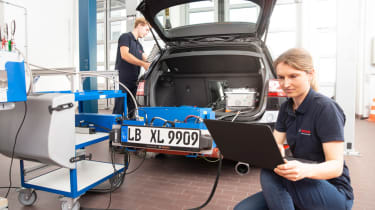Electric cars are also assessed more stringently under WLTP than they were under NEDC. They start with a full battery, and are subjected to the same fuel economy cycle petrol and diesel cars undertake. Once the cycle is complete their batteries are recharged, and a meter measures how much electricity has been used during the trial. The EV’s range is calculated based on how far and how fast it has travelled during the test.
Where do real-world RDE tests come into it?
European legislators introduced new real-world tests at the same time WLTP laboratory assessments came in. The RDE (Real Driving Emissions) test sees cars have a Portable Emissions Measurement System (PEMS) fitted to their rear to measure particulate matter, fuel economy and nitrogen oxide (NOx) emissions, and taken out on public roads for 90-120 minutes.

RDE tests have to be carried out and logged by manufacturers – both a particulate matter and NOx emission element have to be passed.
Are cars assessed under WLTP still Euro 6 models?
Yes. Euro 6 standards arrived in 2014-15, setting a limit of 80 milligrams per kilometre (mg/km) for NOx for diesel cars (60mg/km for petrols) and 4.5mg/km of particulate matter (microscopic soot and other waste particles) for all passenger cars.
WLTP and RDE economy and emissions tests could still be unrealistic
While WLTP test figures are more accurate and representative than those produced under the older NEDC tests, many motorists still struggle to get close to the official manufacturer stated figures.
In April 2024, a study from the European Commission found that most cars are, on average, 20 per cent less fuel efficient and produce more emissions than the official WLTP figures suggest.
The report studied a sample of 600,000 cars and found that petrol cars were typically 24 per cent more polluting and fuel inefficient then the official ratings suggested, while diesel models were 18 per cent short of their official figures. Plug-in hybrid cars performed even worse, typically emitting more than three-and-a-half times more CO2 in real world driving than their official WLP numbers.
The Commission’s report said that there need to be further steps taken to ensure WLTP tests are more representative of everyday driving conditions, taking into account things like weather and air conditioning usage. In 2025, revised WLTP tests for PHEVs will be implemented using more real-world data to provide a more accurate representation of when the car uses electric power and when the engine eventually kicks in, with other tweaks coming in the coming years to improve laboratory test figure accuracy.
Now check out our list of the most economical cars on sale…
